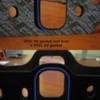quote:
the marque with the prancing donkey and the marque that's full of bull don't install IR FI on their street cars, they install one throttle body per bank of cylinders, 2 in total, not 8 or 12. A runner for each cylinder connects to a plenum serving one bank of cylinders, and there is one throttle body feeding that plenum.
Heh-heh. Prancing Donkey and Full of Bull? -Funny stuff. But, their engines are configured for this type of induction.
quote:
I'm a big proponent for fuel injection conversion, but not of the IR type. I can't argue IR doesn't look good, it does, but it is unnecessarily complicated and expensive, definitely not for everyone.
It’s true that there’s a lot of hardware in multi-cylinder IR induction systems. More throttle bodies and linkage means more cost. It also means the linkage must be well thought through in order to be reliable and maintain tune. Unnecessarily complicated? Compared to what? The old Hillborn mechanical injection systems were IR, simple, and effective, though not optimal. As far as the ECU, the sensors/instrumentation are really no more or less complicated for IR or anything else.
If you are not an engine tuner, and want a bolt-on-and-go system, go buy a mass flow EFI system. But don’t expect to be able to obtain states of tune that are achievable with other approaches. As far as that goes, a good engine tuner with a 4 barrel has shamed many a deep pocketed, would be, EFI "expert". But give a real engine tuner a free hand with engine configuration and EFI….....and he will produce better all around results. And IMO, a better balance can be struck between street behavior and race performance with the combination of EFI & IR. Like everything else, it requires a purpose built engine for IR, and unfortunately >$. For all of the aforementioned reasons, you are absolutely correct, IR is not for everyone.
quote:
I have my personal doubts that it makes any additional horsepower for a motor with a redline of 6500 rpm.
With all due respect, I don’t think 6500 rpm is the driver. The objective of IR is rarely to achieve better peak HP figures, but generally, more avearge torque over a broader the rpm range. If you make higher average torque over a given rpm range, you will accelerate harder even though you may have lower peak HP. This tends to make better drivers out of lesser ones on challenging tracks and shall we say "spirited street driving". Cammed properly, IR has the potential to do so. Just ask the sprint car guys and the likes of Kinsler, Hillborn etc. They’re not delusional. They’re just allowed to run IR. Historically, in carbureted engines, IR produced much stronger signal to the booster, thus throttle response and torque. -Not a factor with EFI. Isolating the runner also allows different LSA and cam profiles. Run similar profiles in an open plenum four barrel and get impressive peak HP but often in fairly narrow rpm ranges, thus peaky engines. So you cam and design the induction system accordingly. If you can’t keep the engine in the sweet spot boys, that peak HP figure will not get you down the road faster.
quote:
Here in the Pantera hobby there is a mystique about FI installations that they are only for the knowledgable insiders. But over in the Mustang hobby, or among the various GM groups like the Camaro guys, retro-fitting FI is no big deal, its done everyday, even folks with limited technical ability install them. The folks outside of the Pantera hobby have 4 advantages, there is plenty of information available to assist them, they are retro-fitting injection onto motors that have been fitted with FI by the manufacturer, there is nobody telling them it is too complicated, and they are not installing independent runner systems. One throttle body is enough, keep it simple.
If you slap a factory ECU and instruments from a Camero, Vette, or 5.0 Mustang on a like sbc or sbf engine, expect like performance. It will definitely be much more economical due to the factory production volumes. In my opinion, deciphering all the factory sensor input, and altering source code for a factory ECU, is more challenging than tuning with an aftermarket ECU. But, there’s lots of people doing it, selling PROMs etc., and you definitely can get good bang for your buck in the early steps up from stock . Getting into the higher states of tune costs increasingly more……and boys, it’s never enough!!!!!
Always a healthy discussion George. –Best wishes to you and your family for a very happy New Year.
Kelly








